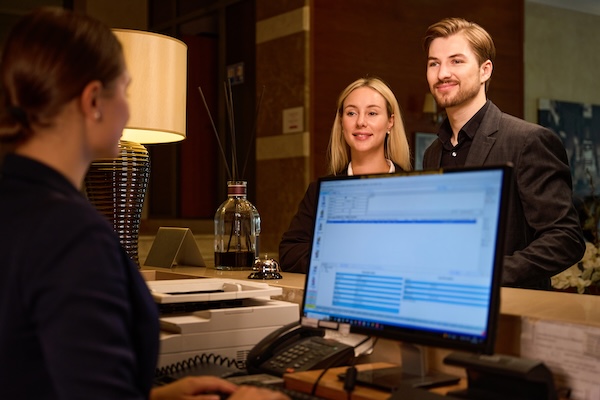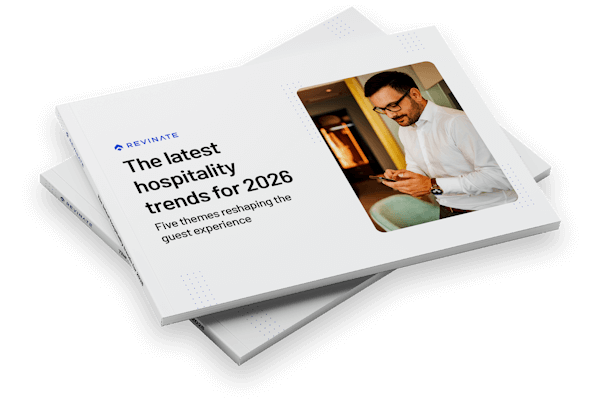Beyond points: Building a customer loyalty strategy that drives direct revenue
Beyond points: Building a customer loyalty strategy that drives direct revenue
True hotel customer loyalty reveals itself in moments like this: A guest walks into your lobby after a long day of travel, and your front desk agent greets him by name, “Welcome, Mr. Johnson! It’s so nice to have you back for a third visit with us. Would you like me to send up a late-night snack? Maybe a slice of that chocolate cake you loved last time?”
No points were exchanged, no app notification — yet that guest just experienced the kind of recognition that transforms casual visitors into lifetime advocates.
While 675 million travelers are enrolled in hotel loyalty programs across major global brands and memberships grew 14.5% in 2024 (more than double room growth rate), many properties aren’t making the most of these memberships. They’re still stuck in the outdated “earn points, get perks” playbook as opposed to creating meaningful connections that go beyond transactional rewards.
The reality? Today’s travelers want more. They crave personalization, exclusivity, and genuine recognition over another free night they’ll struggle to redeem. Properties winning the loyalty game understand that customer loyalty in hotel industry circles is about making guests feel seen, valued, and remembered. That’s what drives direct bookings and keeps them coming back.
In this comprehensive guide, you’ll discover how to move beyond basic points-based programs toward strategies that create real emotional investment — helping you reduce online travel agency (OTA) dependency, increase direct bookings that protect your margins, and build deeper guest relationships.
What is hotel customer loyalty?
Hotel customer loyalty is the emotional and behavioral commitment guests develop toward your property, driving them to choose your hotel repeatedly over competitors and recommend you to others. But here’s where many hoteliers get it wrong: True customer loyalty in the hotel industry goes far beyond collecting stamps on a frequent-stay card or chasing traditional reward redemptions.
When you’ve earned legitimate customer loyalty, your guests don’t even consider shopping your competitors. They don’t nitpick your rates against OTAs. They call you directly because they trust you’ll take care of them the way they’ve come to expect.
To understand modern hotel customer loyalty, you need to recognize these critical distinctions:
- Transactional vs. emotional loyalty. Transactional loyalty is surface-deep; guests return because of discounts, points, or perks they can calculate. Meanwhile, emotional loyalty runs much deeper; guests choose you because of how you make them feel valued, understood, and special.
- Bought vs. earned loyalty. Bought loyalty relies on bribing guests with rewards and discounts to keep them coming back. Conversely, earned loyalty is cultivated through exceptional experiences, personalized service, and genuine recognition.
Why is hotel customer loyalty important?
If you’re still questioning the value of a hotel customer loyalty program, the numbers speak for themselves. Hotel guest loyalty has shifted from perks to a revenue powerhouse that can help make or break your bottom line.
The revenue impact:
- Hotel loyalty program revenues hit $1.2 billion in 2024 — and you want your piece of that pie.
- Loyal guests spend 22.4% more and stay 28% longer than non-members.
- Loyalty members accounted for 52.8% of occupied rooms in 2024, up two percentage points from 2023 and far outpacing overall U.S. demand growth of just 1.2%.
Beyond its profit-driving potential, though, the function of a hotel guest loyalty program allows you to create direct relationships with your most valuable guests, capturing their preferences and behaviors and giving you the data you need to personalize their experiences. More importantly, it strengthens your relationships with them, making it harder for competitors and OTAs to poach them.
When you nail your loyalty program, you’re not just filling rooms — you’re filling them with guests who spend more, stay longer, book direct, and become your biggest advocates.
Why traditional points-based programs fall short
Customer loyalty programs hotels traditionally implement are often still stuck in the transactional mindset, yet today’s travelers prefer rewards that actually enhance their travel experiences.
Personalization is the new loyalty, with 73% of customers expecting brands to understand their needs, and 90% of them expecting tailored experiences. That means your guests aren’t just hoping for personalization — they’re demanding it.
Customer loyalty in hotels now starts with truly knowing your guest. Instead of treating everyone the same way, use your guest data and segment customers by behavior, stay patterns, interests, and preferences:
- Business travelers may value late checkout and workspace amenities over welcome drinks.
- Leisure guests could prefer discounts on local experiences based on their interests and flexible cancellation policies.
- Repeat visitors want recognition of their preferences without ever needing to ask.
When we dig into what travelers really want from loyalty programs, we see a significant rise in interest in unique experiences and other benefits that go beyond getting “free stuff.” This shift represents a real opportunity to redefine customer loyalty programs in hotel industry standards, moving away from point accumulation toward experiential benefits — think exclusive access to rooftop events, private chef experiences, or curated local tours.
5 hotel customer loyalty strategies for direct revenue
Building a successful guest loyalty program isn’t about copying what the big chains do; it’s about creating strategies that align with guests’ interests and behaviors. Here are five proven approaches that drive direct bookings and help increase guest lifetime value.
1. Use guest data to deliver relevant perks
Start paying attention to what your guests actually do, not just what they say they want. Your customer data platform (CDP) holds detailed guest profiles that are goldmines of behavioral insights, and they can transform generic perks into meaningful gestures.
For instance, if your data shows that a guest always books spa services during their stays, surprise them with a complimentary 15-minute massage add-on or early spa access. Business travelers who consistently use your gym might appreciate priority equipment reservations or complimentary protein bars. Families who book connecting rooms could receive welcome amenities for kids or late checkout without asking.
This approach to customer loyalty in hotels works because it demonstrates you’re paying attention. When they feel understood — and not just marketed to — they’re more likely to book direct for future stays. The key is using data to anticipate needs, instead of just reacting to requests, creating those “how did they know?” moments that foster emotional connections and drive repeat business.
2. Create exclusivity through tiered guest loyalty programs
Nothing drives hotel customer loyalty quite like making guests feel extra special with exclusive experiences. Tiered programs work because they tap into our natural desire for status and recognition while encouraging higher spending patterns.
Consider creating invitation-only tiers for your top 10% of guests, offering perks like private check-in areas, wine cellar access, or VIP-only rooftop lounge happy hours. Mid-tier guests might receive priority reservations at your restaurant and complimentary late checkout, while entry-level members get welcome amenities and local experience vouchers.
The magic happens when guests can see the next tier and know what they’re working toward. A guest just two stays away from accessing your executive lounge will likely book direct to reach that reward. This tiered model fuels benefits of customer loyalty in hotels by increasing guest spend while reducing reliance on OTAs, since the most valuable rewards are tied to direct relationships.
3. Offer experience-based rewards that drive emotional loyalty
Guest loyalty thrives on memorable moments. Experience-based rewards create emotional connections that last far longer than any points balance, and they’re often more cost effective than traditional perks.
Think beyond typical amenities and focus on unique experiences your property can deliver. Partner with local businesses to offer exclusive wine tastings, cooking classes with your chef, or behind-the-scenes tours of your city. Surprise long-term guests with handwritten welcome notes from your general manager, or arrange for their favorite local restaurant to deliver dessert to their room.
The follow-up matters just as much as the experience itself. Send personalized thank-you emails after their stay, referencing specific moments from their visit. These touchpoints reinforce the emotional connection and remind guests why they chose to book direct vs becoming an OTA guest.
4. Tap into “hidden loyalty” incentives
Customer loyalty in hotel industry spaces doesn’t always require formal program enrollment to reward loyal behavior. “Hidden loyalty” uses your guest data to recognize repeat visitors automatically, allowing you to create surprise-and-delight moments that feel like personal touches rather than part of an obvious rewards program.
Your CDP can identify returning guests even if they’ve never joined a formal program. When someone books their third stay in 18 months, trigger automatic upgrades, welcome amenities, or personalized service notes. Send a “welcome back” e-mail mentioning their last visit or preferred room type.
This approach works particularly well for guests who are skeptical about formal loyalty programs but still demonstrate loyal behavior.
5. Offer loyalty exclusives for direct bookers
Driving repeat bookings without relying on OTAs starts by making direct booking the clear winner for loyal guests. Focus on value they can’t get anywhere else.
Create exclusive packages for loyalty members, like a “Loyal Guest Rate” that includes breakfast, Wi-Fi, and late checkout at a price point that beats OTA offerings. Use guest data to tailor offers: Maybe corporate travelers get high-floor rooms and express laundry service, while leisure guests receive local experience add-ons and free parking.
Don’t forget to recover abandoned bookings. Send follow-up emails with exclusive rates for guests who start but don’t complete their direct reservation.
The key is making these offers exclusive to direct bookers. When guests see that the best value comes from booking direct, you create a compelling reason for them to bypass third party sites.
How to measure the success of your hotel guest loyalty strategy
Measuring loyalty program success isn’t just about tracking how many people join your program. Instead, it’s about understanding whether your hotel guest loyalty program is truly driving revenue and influencing guest behavior.
Here are the key metrics that matter:
- Repeat direct booking rate. What percentage of loyalty members return and book directly?
- Loyalty program opt-in rate. What percentage of eligible guests actually join your program during or after their stay?
- Customer lifetime value (CLV). How much revenue does each member generate over their relationship with your hotel?
- Revenue per loyalty member. Are loyalty members spending more per stay than non-members?
- Direct booking conversion rate. How many loyalty program inquiries or sign-ups convert into direct reservations?
- Member retention rate. What percentage of members return and book again within 12 to 18 months?
- Program engagement rate. How actively do members interact with your offers, emails, and loyalty touchpoints?
Another important factor is measuring your loyalty numbers against industry benchmarks. If your loyalty members aren’t driving at least 40% to 50% of your occupied rooms, or you’re not seeing a 20%+ spending increase from program participants, you’re likely leaving money on the table compared to industry leaders.
When you focus on metrics that actually move the needle, you’ll get a much clearer picture of how your customer loyalty strategy is performing — or where you need to make some adjustments.
Level up your customer loyalty strategy today
The era of basic points-and-perks programs is over. Today’s most successful loyalty strategies go beyond transactional rewards and focus on building genuine emotional connections with guests.
You now have the road map for building a customer satisfaction and loyalty program that actually works: Use guest data to deliver relevant perks, create tiered exclusivity, offer experience-based rewards, tap into hidden loyalty opportunities, and make direct bookings the obvious choice for your most valued guests.
How to increase customer loyalty in hotel operations isn’t just about retention anymore — it’s about creating advocates who choose you first and recommend you often.
Ready to transform your approach? Sign up for our Direct Booking Mastery Certification program and learn how to build loyalty that turns stays into stories and drives real revenue results.
This site is protected by reCAPTCHA and the Google Privacy Policy and Terms of Service apply. View our Terms & Conditions here. *Required fields.






